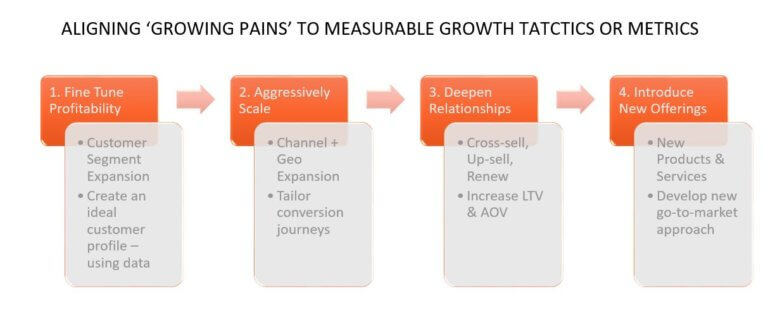Navigating the 4 paths for growth out of the COVID-19 pandemic.

2020 is the year none of us could have ever predicted. It’s forced many of us to throw our annual business and sales targets out the window and pivot like never before. Absorbing the initial shock of the COVID-19 pandemic in the first half of the year was no walk in the park. But as this crisis has carried on, we’re learning how to adapt our playbook as we go.
In my last post, I explained how marketing, especially during times of economic uncertainty, can be a business’s best strategic lever for growth. Unfortunately, it’s all too common for marketing to be first on the chopping block during economic downturns. But it’s our belief at LQ Digital that, when done right, marketing can shed its undeserved reputation as a cost center and, instead, take the lead as a revenue-generating powerhouse.
Several industries have thrived during this tumultuous time because they leveraged marketing in smart and measurable ways. But now that we’ve entered the last quarter of the year, we just want 2020 to be over—and for a vaccine to put the global economy back on track once again. With this as our backdrop, we must be laser-focused on building out plans for recovery. The question is: How can you build a bullet-proof plan for success in 2021?
Growth is the destination, but many paths can get you there
Building a strategy for growth isn’t always easy. There are many paths that businesses can take—some clearer than others—to arrive at a desired end goal. That’s why picking the right path can make all the difference. Unfortunately, this is where businesses often get lost.
At LQ Digital, we’ve worked with businesses of all shapes and sizes. Whenever they come to us looking for advice on how to spark meaningful growth, we notice a few common challenges:
- They lack an up-to-date ‘growth thesis’
A growth thesis is a very simple and clear framework for what activities will get you from your business today to where it needs to go tomorrow. - They lack actionable data to inform decision-making
This is a recurring problem across the board. Our clients are drowning in data, but often not the right data—which we define as simple, pragmatic, and action-oriented. We are looking for the key signals that prove a business’s economics of growth. - They lack a cross-functional alignment on success
Growth goals can’t live in a silo. It’s absolutely critical for sales, marketing, and finance organizations to work together to create a unified path towards measurable growth.
We constantly see these as roadblocks to driving impressive growth. Simply put, you’re either growing against the market or slowly dying—to quote a phrase.
Navigating out of this mess towards recovery is certainly possible. But you really can’t do it unless you’ve built a solid ‘growth thesis’ to guide your business forward.
Architecting your own ‘growth thesis’
A growth thesis is one of the core pillars that influences everything we do at LQ Digital. Now it’s time to build your own. A growth thesis is a simple way of communicating how you plan to drive growth in a way that all parts of a business can understand clearly and deliver on.
A growth thesis consists of two core elements:
- Growth Statement: A one-sentence rallying cry that outlines, in simple terms, your highly-focused growth outcome as well as the data you’ll use to prove you succeeded.
- Key Growth Play: Many of our customers tell us that they will do “this” and “that” to achieve growth. While that may be technically true, our goal is to get them to focus exclusively on the play that will get them to their growth goal.
A simple, yet powerful statement
A growth statement needs to be short, sweet, and memorable for it to stick. As a starting point, aim for 15 words or less, make it easily repeatable when spoken aloud, and ensure that it’s clear for all parts of a business to understand, digest, and put into action.
Here are a couple examples of what this may look like:
- Subscription Business: “Grow customer purchases by 60%, by engaging a new, middle-market customer.” The path to action is clear (targeting a new customer segment) while the measure for success is the total number of new customer purchases.
- Fin-Tech Business: “Increase customer LTV from $800 to $1,200 by activating new advisors on the platform.” In this example, the path to action is clear (offering additional services) while the measure of success is a specific increase in LTV.
Honing in on your key growth play
What you end up defining as your growth thesis needs to revolve around a single growth play that can drive alignment across all key players. This typically breaks down into four categories:
- Fine-Tune Profitability
- Aggressively Scale
- Deepen Relationships
- Introduce New Offerings
These primary levers of growth allow our team to more effectively guide businesses towards a winning path to growth. This sometimes makes our customers uncomfortable because we make them put a stake in the ground around what single strategy will get them to their end goal. Attempting to tackle multiple goals all at once signifies a lack of focus around a top business priority—and that can quickly compromise results.
For example, our customers will often tell us that they need to drive scale AND reduce CAC. Asking them to articulate what goal they cannot miss is how we get them to prioritize one objective over the other. In most cases, the answer to this prioritization question is that scale can’t be missed while there’s a little wiggle room around CAC.
Here are a few more examples showing how this works in the real world. If customers want to “reduce CPA” or “improve ROAS,” they really want to fine-tune profitability. If they voice a desire to “grow AOV,” they are likely interested in deepening customer relationships or introducing new product or service offerings. And finally, if they say, “We must figure out Facebook” or “Expand our target audience,” it means they are looking to scale aggressively.

Understanding a customer’s desired path to growth in this utterly straightforward way makes it possible for us to offer specific and measurable solutions for achieving these goals. It creates a North Star for our execution and keeps all of us focused on the end game.
Why even develop a growth thesis in the first place?
If you’re currently charting a new path for business recovery out of this pandemic, the last thing you need is another long-winded Powerpoint deck that fails to lay out an actionable framework for driving growth. Our focus should always be on simplifying growth.
This is why we believe wholeheartedly in the concept of a growth thesis. If you ask yourself the tough questions and get to the heart of what’s really limiting your business’s growth potential, you’ll most likely find that being unable to lead your team—and all resources—towards the same outcome is your biggest obstacle.
A growth thesis is a way to crystallize, prioritize, and mobilize. When done right:
- A growth thesis is a rallying cry
Because a growth thesis marries a single goal with a clear way of measuring success against that goal, it becomes the ideal sound byte that you—and your entire business—can say over and over again until everyone is marching to the same drum. - A growth thesis provokes new thinking
When the destination is crystal clear, new ideas emerge about how to achieve the goal. - A growth thesis prioritizes outcomes, not activities
Because a growth thesis is rooted in measurable outcomes, it’s easier to set the ‘golden metric’ and then determine the right tactics to execute. - A growth thesis is open to revision
We could have called this a ‘growth hypothesis,’ but it’s not an experiment. It’s an ‘all in’ approach to execution that helps you place the right strategic bets. But even as a line drawn in the sand, it offers just enough flexibility to refine, revise, and change course based on ever-evolving business needs and priorities.
Spark business recovery with a growth thesis
At LQ Digital, we help our customers hone in on outcomes as well as the metrics to measure those outcomes that will improve a business’s chances of achieving real and meaningful growth.
We know the power that a growth thesis can bring to all businesses, so we thought we’d fill you in on our little secret. And given the challenges we’re all facing during this unprecedented time— whether or not building a strategy for economic recovery now or in the months ahead is your prerogative—thinking about your business’s path to growth should always be top-of-mind.
Of course, if you’d like help getting started, our team is always ready. Contact us today.





